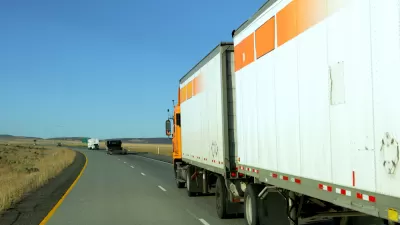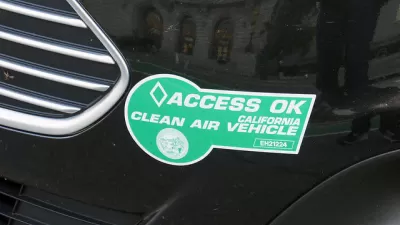Come November 1, gasoline and diesel taxes will increase by 12 and 20 cents per gallon, respectively, in California, providing badly needed revenue to repair roads, bridges, and improve transit, but truck pollution loophole will still foul the air.

After Gov. Jerry Brown signs the Road Repair and Accountability Act into law as expected, "owners of trucks that currently meet California rules cannot be required to retire or upgrade their rigs until their machines are either 13 years old or have traveled at least 800,000 miles," reports David Danelski, an investigative and environmental reporter for The Press-Enterprise newspaper in Riverside, California.
As posted earlier, the main challenge that faced the governor and Democratic leadership pushing the controversial transportation funding bill was reaching the two-thirds supermajority of supporters needed in both legislative chambers. Without the trucking emissions provision in "SEC. 18. Section 43021" in SB 1, leaders felt it would be impossible.
Danelski presents two opposing viewpoints on how that controversial provision will affect air quality.
Tremendous setback to air quality improvement efforts, particularly in Southern California.
"Diesel trucks are the largest source of smog-forming nitrogen oxides in Southern California, accounting for more than 25 percent of emissions," notes Danelski.
You can’t take the largest source off the table,” said Dr. Joseph Lyou, a member of the South Coast Air Quality Management District board and president of the Coalition for Clean Air who was appointed to the board by Gov. Arnold Schwarzenegger. “How can you possibly make that up?”
Furthermore, indirect source emission "rules now under consideration that would require seaports, rail yards, warehouse-distribution centers and government fleets to use cleaner trucks would be more vulnerable to legal challenges, the regional air-quality officials said."
On the opposing side, state transportation officials believe that "SB 1 will reduce overall truck emissions because the legislation requires the state Department of Motor Vehicles to enforce existing rules that require trucks now operating to meet the 2010 standard for new trucks within the next six years." See "SEC. 45. Section 4000.15" of the bill's text.
Translation: if the truck doesn't meet emissions standards now, the enforcement becomes more rigorous, but if trucks are now compliant with the California Air Resources Board's Truck and Bus Rule, they enjoy great financial savings at the expense of increased diesel emissions in later years.
In summary, similar to the $1 billion in side deals needed to woo just a few reluctant legislators, infrastructure won-out over public health due to the state constitution's onerous requirements regulating bills that increase taxes.
Hat tip to MTC-ABAG Library.
FULL STORY: Gas tax bill — designed to fix California’s roads — could lead to more smog

Maui's Vacation Rental Debate Turns Ugly
Verbal attacks, misinformation campaigns and fistfights plague a high-stakes debate to convert thousands of vacation rentals into long-term housing.

Planetizen Federal Action Tracker
A weekly monitor of how Trump’s orders and actions are impacting planners and planning in America.

In Urban Planning, AI Prompting Could be the New Design Thinking
Creativity has long been key to great urban design. What if we see AI as our new creative partner?

King County Supportive Housing Program Offers Hope for Unhoused Residents
The county is taking a ‘Housing First’ approach that prioritizes getting people into housing, then offering wraparound supportive services.

Researchers Use AI to Get Clearer Picture of US Housing
Analysts are using artificial intelligence to supercharge their research by allowing them to comb through data faster. Though these AI tools can be error prone, they save time and housing researchers are optimistic about the future.

Making Shared Micromobility More Inclusive
Cities and shared mobility system operators can do more to include people with disabilities in planning and operations, per a new report.
Urban Design for Planners 1: Software Tools
This six-course series explores essential urban design concepts using open source software and equips planners with the tools they need to participate fully in the urban design process.
Planning for Universal Design
Learn the tools for implementing Universal Design in planning regulations.
planning NEXT
Appalachian Highlands Housing Partners
Mpact (founded as Rail~Volution)
City of Camden Redevelopment Agency
City of Astoria
City of Portland
City of Laramie





























